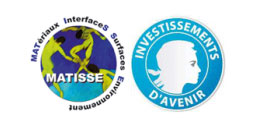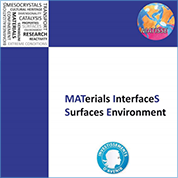DIMENSIONALITY AND CONFINEMENT
Axis 4 entitled "Dimensionality and Confinement" gathers 5 laboratories (CRC, CR2MF, LPEM, IMPMC, INSP) and 11 teams. The scientific themes being explored in the framework of axis 4 are: electronic confinement and transport, magnetism, growth of materials for electronic and optical confinement, confinement of optical and acoustical waves and cultural preservation. Each of these themes is explored by several teams or laboratories.
Electronic confinement and transport (LPEM, IMPMC, INSP)
The objective is to study the impact of confinement and dimensionality on materials properties, with particular emphasis on electronic properties (e.g. confined superconductivity) as well as electronic and phononic transport at the nanoscale. Ultimately, the use of these novel materials in devices is assessed. Research developed along these lines implies the study of materials in a range of dimension not previously explored or the study of new materials where dimensionality reduction and confinement effects play naturally a central role, such as novel 2D materials with singular electronic properties (e.g. graphene @ INSP+IMPMC, silicene @ INSP, chalcogenide lamellar compounds @ IMPMC), 2D systems at surfaces and interfaces (e.g. confined superconductivity at oxide interfaces @ LPEM, Dirac fermions at the surface of topological insulators @ INSP & LPEM), and single nanoparticles (e.g. Coulomb blockade in Au nanoparticles for single charge electronics @ INSP, confined superconductivity in Pb island @ INSP, spectroscopy of single colloidal dot @ LPEM). State of the art experimental techniques (e.g. STM/STS @ INSP & LPEM, synchrotron advanced techniques…) are used to probe the systems properties. Moreover, this is complemented by the work of the theoretical group at IMPMC interacting with experimentalists on several key aspects such as inelastic spectroscopy of quasi-particles, electron-phonon couplings, doping in 2D nanolayers.
Magnetism (INSP, IMPMC)
Exploring the impact of dimensionality and confinement on the magnetic properties of materials is applied to distinct classes of materials. At INSP, studies focus on spin and magnetization in nanostructured materials as potential vectors for information storage and processing. At IMPMC, the emphasis is put on low-dimensional magnetic systems of interest in mineralogy.
Materials for electronic and optical confinement (INSP, LPEM), Wave confinement in nanostructures (INSP)
Luminescence properties of quantum dots are related to electronic confinement. In INSP, growth of quantum dots, assured by molecular beam epitaxy, are used by several groups for example as acoustically driven photons sources. In LPEM, colloidal of II/VI semi-conductor quantum dots are synthetized for applications in biological imaging (LPEM), solar cells (LPEM) or as single-photon sources (INSP-LPEM). Included in single nano-objects (nanopilars, nanoantenna), they exhibit specific quantum properties. Optical confinement gives rise to iridescence for materials like opals synthetized and studied in INSP, or butterflies. Polymer molding of butterfly wings should permit the fabrication of original material with specific optical properties. The clean room of INSP permits the structuration of materials at micro and nanoscale like phononic crystals …
The structuration of matter makes it possible to confine waves in very small volumes. THz coherent phonon sources, acoustic –magnetic coupling, manipulation of spin waves could be achieved.
Cultural heritage preservation (CRC, C2RMF, INSP)
This activity on cultural heritage and its preservation is lead by CRC and CR2MF, with collaborations with INSP (for example on yellowing of statues after laser cleaning).
Funded projects
Materials for optical confinement
- 2012 PhD of M. Thomé - S. Berthier (INSP), L. Nicole and N. Nassif (LCMCP) Replication of multi-scale and multifunctional natural structures -
- 2013 PhD of C. Bourdillon - C. Schwob (INSP) and M. C. Fauré (INSP) Fluorescence manipulation for nano-emittors inside opals
- 2014 PhD of S. Cervera - P. Atkinson (INSP) and Y. Klein (IMPMC) Fabrication of an acoustically driven single-photon source
Magnetism
- 2013 Post-D of N. Daffe - P. Sainctavit (IMPMC) and V. Dupuis (PHENIX) Anisotropies and magnetic coupling for texturable ferrofluids
- 2014 PhD of N. Mas - M. Trassinelli (INSP) and M. Marangolo (INSP) Suppression of thermal hysteresis in giant magneto-calorific materaisl at room-temperature
Electron confinement
- 2013 PhD of R. Federicci - B. Léridon (LPEM) and A. Shukla (IMPMC) Electronic transport in oxide nanosheets
- 2013 Post-D of T. Brumme - M. Calendra, A. Shukla (IMPMC), M. Marangolo (INSP) Theoretical modeling
- 2014 Post-D of J. Biscaras - A. Shukla and E. Maisonhaute (LISE) 2D materials edge and defects: TERS nano-spectroscopy
- 2012 Post-D of R. Doherty - O. Pluchery (INSP) and A.-F. Lamic-Humblot (LRS) Gold nanoparticles for single charge electronics
Highlights
- Theoretical modelling of electrochemically-doped superconducting nanolayers
The recent development of electric double-layer field-effect devices based on liquid electrolytes [Fig. 6(a)] permits the tuning of carrier density in systems composed of a few atomic layers (nanolayers). The advantages of electrochemical versus chemical doping are that the number of carriers can be tuned continuously, the use of a liquid electrolyte medium allows to reach surface charge-densities of the order of 5×1014 electrons/cm2 and, finally, any weakly-conducting semiconductor or metal that can be exfoliated or grown epitaxially can be doped and potentially transformed in a superconductor.
A theoretical modelling of field-effect doping of nanolayers was lacking. A first principles theoretical approach able to describe the effects of a strong electric field and the electrochemical doping (charging) of layered quasi 2D compounds has been developed during the post-doctoral sojourn of T. Brumme, founded by MATISSE, in the IMPMC theory group. The method has been applied to dichalcogenides and ZrNCl. The findings imply a substantial revision of the phase diagram of electrochemically doped ZrNCl and elucidate crucial differences with superconductivity in Li-intercalated bulk ZrNCl [Fig. 6(b)]. In the case of dichalcogenides, the group was able to provide the mapping between the doping charge and the Hall coefficient, a key parameter for experimentalists [see 8, 9].
Figure 6: (a) Electric double-layer field effect transistor. The gate potential (VG) moves the positively charged ions in the ionic liquid to the outer Helmoltz plane at approximately 1 nm from the ZrNCl surface. A negative polarization charge is formed on the surface of ZrNCl. An electric double layer capacitor with a sheet of the solvating molecules as dielectric layer is formed. (b) Phase diagram of Li intercalated ZrNCl and Field effect (FET) doped ZrNCl. The red dots and the black dashed lines show the revised phase diagram (Post-doctoral work of T. Brumme).
Replication of muti-scale and multifonctional natural structures
Natural structures like butterfly wings present complexity and multiscale ordering. For a morpho, a tropical butterfly, at scales from nm to cm, the underlying structures confers to the wings specific properties: blue metallic color, self-cleaning and hydrophobic properties. The objective is to reproduce the wing structure by sol-gel molding, plasma deposition or biomineralisation. This work (PhD of M. Thomé) is sustained by numerical simulations predicting optical properties [10-12].
Gold nanoparticules for single charge electronics
Molecular and nanoparticules are promising tools for nanoelectronics. Interaction between arrangement of nanoparticules and molecular layers on crystalline substrate has important influence on energy level, optical properties and electronic transport, like the quantum coulomb blockade: small size nanoparticles (5-10nm) stock single electronic charge which can be extracted one by one under STM tip. These properties have been evidenced with a STM microscope which permits to connect nanoparticles individually [13-15].
Figure 7: Scheme of a double tunnel junction constituted by a silicon substrate, a molecular layer, a gold nanoparticle (6 nm of diameter) and a STM tip. When the tip is polarized with respect to the substrate, electrons cross one by one the junction. At 40K, the current increases with applied voltage by steps of 10 pA. (Post-doctoral work of R. Doherty)
Benefits of MATISSE
MATISSE has a structuring action by giving rise to new collaborations, a necessary condition for getting a funded project. In particular, the field of new 2D electronic materials is one of the most active emerging fields in condensed matter physics in last few years. In such a context, MATISSE by funding several collaborative projects on 2D materials (nanolayers, new oxide lamellar phases, silicene, topological insulators…), has a significant impact. In the other fields, new themes have emerged (optical confinement, magnetism or 0D confinement,) which carried on even after the departure of the post doc (2012 Thesis are not finished yet).
In the context of MATISSE, scientific meetings permit discussion and give rise to new collaborations (funded or informal ones). A day on topological insulators has been organized in 2013. In May 2015, a scientific meeting on “waves” will be organized.
Also in the section
Key figures
MATISSE :
4 disciplines
- Chemistry
- Physics
- Earth Science
- Cultural heritage
18 partners
400 researchers
Contact
Direction :
Florence Babonneau
Administration :
Laurence Bonnet-Lericque
Communication :
Tél. (33) 1 44 27 62 36




